High Impact Tutoring Built By Math Experts
Personalized standards-aligned one-on-one math tutoring for schools and districts
In order to access this I need to be confident with:
SubstitutionCoordinates math
Straight line graphs
Rate of change formula
Perpendicular lines Absolute valueDistance formula
Here you will learn about the distance formula, including how to find the distance between two coordinates.
Students first learn about the distance formula in 8th grade as a part of geometry, and again in high school geometry as a part of expressing geometric properties with equations.
What is the distance formula?
The distance formula (also known as the Euclidean distance formula) is an application of the Pythagorean theorem a^2+b^2=c^2 in coordinate geometry.
It will calculate the distance between two cartesian coordinates on a two-dimensional plane, or coordinate plane.
To do this, find the differences between the x- coordinates and the difference between the y- coordinates, square them, then find the square root of the answer.
This can be written as the distance formula,
d=\sqrt{\left(x_2-x_1\right)^2+\left(y_2-y_1\right)^2}where d is the distance between the points \left(x_1, y_1\right) and \left(x_2, y_2\right).
For example,
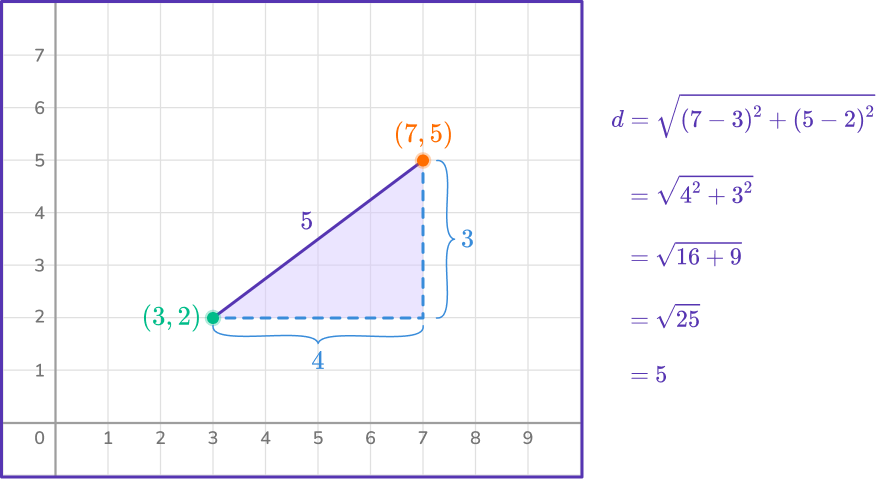
The line segment between the first point and the second point forms the hypotenuse of a right angled triangle.
The length of the hypotenuse of the right triangle is the distance between the two end points of the line segment.
What is the distance formula?
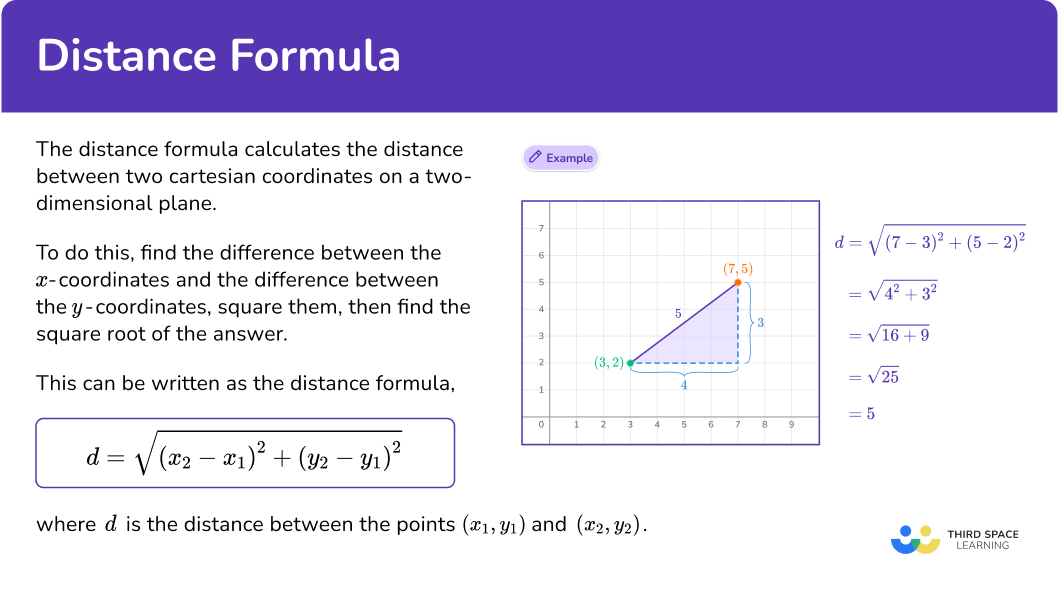
Common Core State Standards
How does this relate to 8 th grade math?
- Grade 8 – Geometry (8.G.B.8)
Apply the Pythagorean Theorem to find the distance between two points in a coordinate system.
![[FREE] Distance Formula Worksheet (Grade 8)](https://thirdspacelearning.com/wp-content/uploads/2025/01/Distance-Formula-Worksheet-listing-image.png)
[FREE] Distance Formula Worksheet (Grade 8)
![[FREE] Distance Formula Worksheet (Grade 8)](https://thirdspacelearning.com/wp-content/uploads/2025/01/Distance-Formula-Worksheet-listing-image.png)
Use this worksheet to check your 8th grade students’ understanding of distance formula. 15 questions with answers to identify areas of strength and support!
DOWNLOAD FREE![[FREE] Distance Formula Worksheet (Grade 8)](https://thirdspacelearning.com/wp-content/uploads/2025/01/Distance-Formula-Worksheet-listing-image.png)
[FREE] Distance Formula Worksheet (Grade 8)
![[FREE] Distance Formula Worksheet (Grade 8)](https://thirdspacelearning.com/wp-content/uploads/2025/01/Distance-Formula-Worksheet-listing-image.png)
Use this worksheet to check your 8th grade students’ understanding of distance formula. 15 questions with answers to identify areas of strength and support!
DOWNLOAD FREEHow to use the distance formula
In order to use the distance formula, you need to:
- Identify the two points and label them \bf{\left(\textbf{x}_{1}, \textbf{y}_{1}\right)} and \bf{\left(\textbf{x}_{2}, \textbf{y}_{2}\right)}.
- Substitute the values into the formula, \bf{\textbf{d}=\sqrt{\left(\textbf{x}_2-\textbf{x}_1\right)^2+\left(\textbf{y}_2-\textbf{y}_1\right)^2}}.
- Solve the equation.
Distance formula examples
Example 1: distance between two points on a coordinate axes in the first quadrant
Find the distance between the points A and B.
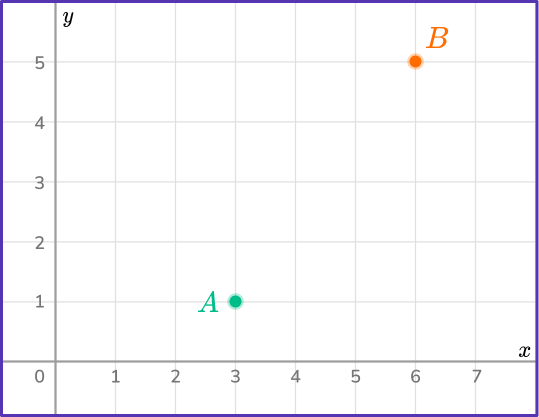
- Identify the two points and label them \bf{\left(\textbf{x}_{1}, \textbf{y}_{1}\right)} and \bf{\left(\textbf{x}_{2}, \textbf{y}_{2}\right)}.
A=(3,1) and B=(6,5).
Let \left(x_{1}, y_{1}\right)=(3,1) and \left(x_{2}, y_{2}\right)=(6,5).
2Substitute the values into the formula, \bf{\textbf{d}=\sqrt{\left(\textbf{x}_2-\textbf{x}_1\right)^2+\left(\textbf{y}_2-\textbf{y}_1\right)^2}}.
\begin{aligned} d&=\sqrt{\left(x_2-x_1\right)^2+\left(y_2-y_1\right)^2} \\\\ &=\sqrt{(6-3)^2+(5-1)^2} \end{aligned}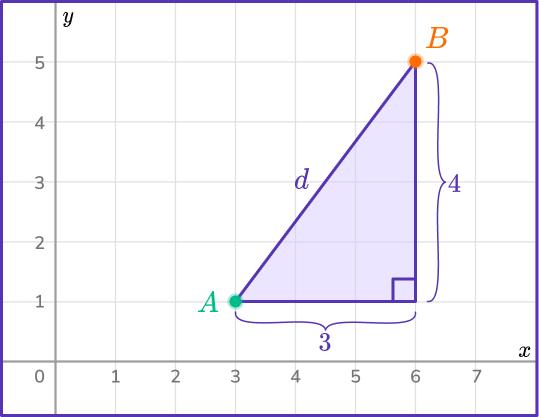
3Solve the equation.
\begin{aligned} & d=\sqrt{(6-3)^2+(5-1)^2} \\\\ & =\sqrt{3^2+4^2} \\\\ & =\sqrt{9+16} \\\\ & =\sqrt{25} \\\\ & =5 \end{aligned}Example 2: find the distance between two points on a coordinate axes
Find the distance between the points A and B.
Give your answer to 1 decimal place.
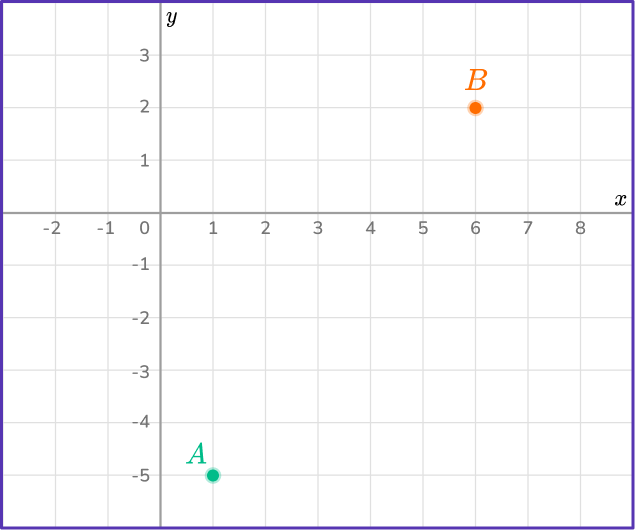
Identify the two points and label them \bf{\left(\textbf{x}_{1}, \textbf{y}_{1}\right)} and \bf{\left(\textbf{x}_{2}, \textbf{y}_{2}\right)}.
A=(1,-5) and B=(6,2).
Let \left(x_{1}, y_{1}\right)=(1,-5) and \left(x_{2}, y_{2}\right)=(6,2).
Substitute the values into the formula, \bf{\textbf{d}=\sqrt{\left(\textbf{x}_2-\textbf{x}_1\right)^2+\left(\textbf{y}_2-\textbf{y}_1\right)^2}}.
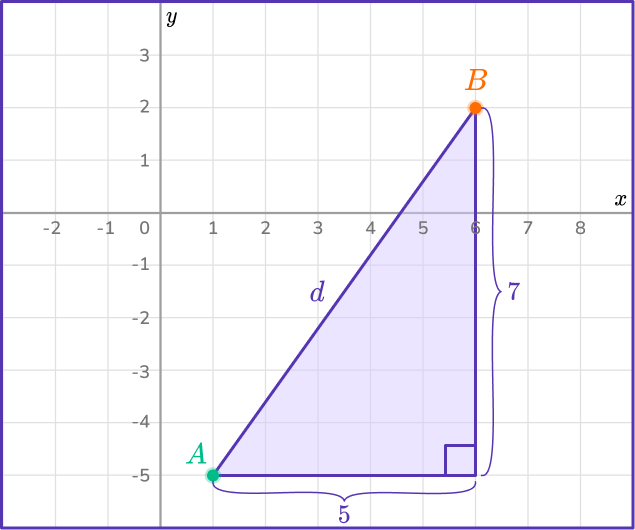
Solve the equation.
Example 3: find the distance between two given points with positive coordinates
Find the distance between the points (1,4) and (7,12).
Identify the two points and label them \bf{\left(\textbf{x}_{1}, \textbf{y}_{1}\right)} and \bf{\left(\textbf{x}_{2}, \textbf{y}_{2}\right)}.
Let \left(x_{1}, y_{1}\right)=(1,4) and \left(x_{2}, y_{2}\right)=(7,12).
Substitute the values into the formula, \bf{\textbf{d}=\sqrt{\left(\textbf{x}_2-\textbf{x}_1\right)^2+\left(\textbf{y}_2-\textbf{y}_1\right)^2}}.
Solve the equation.
Example 4: find the distance between any two given points
Find the distance between the points (-2,5) and (6,-7).
Give your answer to 1 decimal place.
Identify the two points and label them \bf{\left(\textbf{x}_{1}, \textbf{y}_{1}\right)} and \bf{\left(\textbf{x}_{2}, \textbf{y}_{2}\right)}.
Let \left(x_{1}, y_{1}\right)=(-2,5) and \left(x_{2}, y_{2}\right)=(6,-7).
Substitute the values into the formula, \bf{\textbf{d}=\sqrt{\left(\textbf{x}_2-\textbf{x}_1\right)^2+\left(\textbf{y}_2-\textbf{y}_1\right)^2}}.
Solve the equation.
Example 5: finding a missing value given the distance
The distance between the points (1,5) and (16,k) is 17.
Find the value of k, where k is negative.
Identify the two points and label them \bf{\left(\textbf{x}_{1}, \textbf{y}_{1}\right)} and \bf{\left(\textbf{x}_{2}, \textbf{y}_{2}\right)}.
Let \left(x_{1}, y_{1}\right)=(1,5) and \left(x_{2}, y_{2}\right)=(16,k).
It is also stated that d=17.
Substitute the values into the formula, \bf{\textbf{d}=\sqrt{\left(\textbf{x}_2-\textbf{x}_1\right)^2+\left(\textbf{y}_2-\textbf{y}_1\right)^2}}.
Solve the equation.
The question states that k is negative so k=-3.
Example 6: finding a missing value given the distance
The distance between the points (2,9) and (f,10) is 15.
Find the value of f, where f is positive.
Identify the two points and label them \bf{\left(\textbf{x}_{1}, \textbf{y}_{1}\right)} and \bf{\left(\textbf{x}_{2}, \textbf{y}_{2}\right)}.
Let \left(x_{1}, y_{1}\right)=(2,9) and \left(x_{2}, y_{2}\right)=(f, 10).
It is also stated that d=15.
Substitute the values into the formula, \bf{\textbf{d}=\sqrt{\left(\textbf{x}_2-\textbf{x}_1\right)^2+\left(\textbf{y}_2-\textbf{y}_1\right)^2}}.
Solve the equation.
The question states that f is positive so f=17.0 (1dp).
Teaching tips for distance formula
- Use visual aids such as coordinate planes that highlight the x- axis and y- axis, graphs, or geometric shapes to visually represent the distance formula.
- Introduce real-world scenarios where distance calculations are essential. For example, discuss scenarios involving mapping or measuring distances between points in various contexts to allow students to see the relevance of the concept.
- Allow students to explore the distance formula through hands-on activities such as measuring distances on a coordinate plane or calculating distances between objects in the classroom.
Easy mistakes to make
- Confusing the distance formula with the midpoint formula
An easy mistake to make is to find the midpoint instead of the distance.
The midpoint formula is \left(\cfrac{x_{1}+x_{2}}{2}, \cfrac{y_{1}+y_{2}}{2}\right).
- Squaring negative numbers to give a negative
When using the distance formula, it is common to get negative values after the subtraction step. These values will be squared, so it is important to remember that the square of a negative value is positive.
For example, (-3)^2=9.
- Subtracting in the wrong order
When subtracting, a common misconception is to switch the order of subtraction when plugging in the coordinates ( for example, using \left(x_{2}-x_{1}\right) and \left(y_{1}-y_{2}\right).
Ensure that the subtraction is done in the same order for both coordinate values: \left(x_{2}-x_{1}\right) and \left(y_{2}-y_{1}\right).
- Forgetting to simplify
When solving, neglecting to simplify the expression inside the square root is a common mistake. After squaring each term, simplify the expression inside the square root before taking the square root.
Related graphing linear equation lessons
Practice distance formula questions
1. Find the distance between the point (6,8) and the origin.
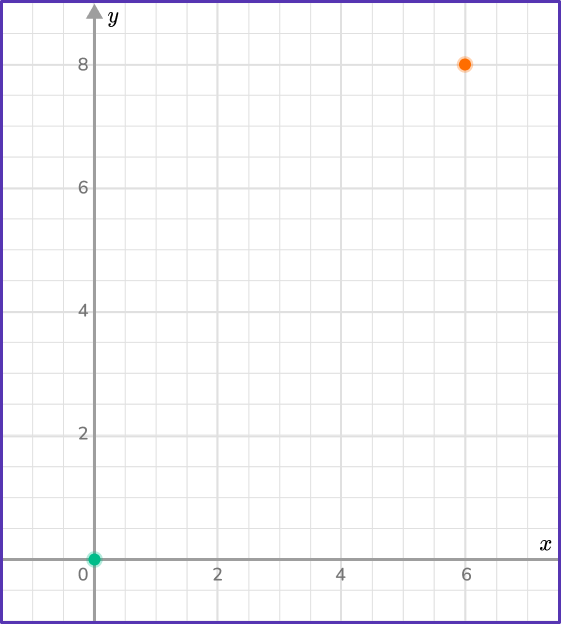




The origin is (0,0) so let (x_{1},y_{1})=(0,0) and (x_{2},y_{2})=(6,8).
\begin{aligned} d&=\sqrt{\left(x_2-x_1\right)^2+\left(y_2-y_1\right)^2} \\\\ & =\sqrt{(6-0)^2+(8-0)^2} \\\\ & =\sqrt{6^2+8^2} \\\\ & =\sqrt{36+64} \\\\ & =\sqrt{100} \\\\ & =10 \end{aligned}
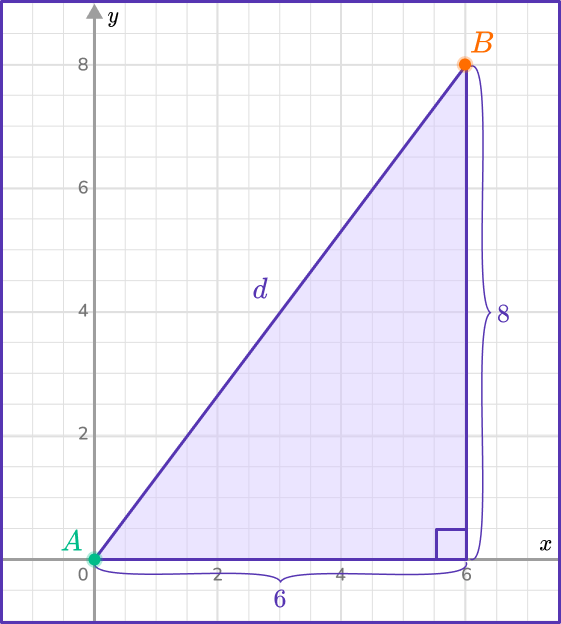
2. Find the distance between the points (0,10) and (24,0).




Let \left(x_{1},y_{1}\right)=(0,10) and \left(x_{2},y_{2}\right)=(24,0).
\begin{aligned} d&=\sqrt{\left(x_2-x_1\right)^2+\left(y_2-y_1\right)^2} \\\\ & =\sqrt{(24-0)^2+(0-10)^2} \\\\ & =\sqrt{24^2+(-10)^2} \\\\ & =\sqrt{576+100} \\\\ & =\sqrt{676} \\\\ & =26 \end{aligned}
3. Find the distance between the points (5,3) and (14,10).
Give your answer to 1 decimal place.




Let \left(x_{1},y_{1}\right)=(5,3) and \left(x_{2},y_{2}\right)=(14,10).
\begin{aligned} d&=\sqrt{\left(x_2-x_1\right)^2+\left(y_2-y_1\right)^2} \\\\ & =\sqrt{(14-5)^2+(10-3)^2} \\\\ & =\sqrt{9^2+7^2} \\\\ & =\sqrt{81+49} \\\\ & =\sqrt{130} \\\\ & =11.4 \text { (1dp)} \end{aligned}
4. Find the distance between the points (-2,4) and (-8,-9).
Give your answer to 1 decimal place.




Let \left(x_{1},y_{1}\right)=(-2,4) and \left(x_{2},y_{2}\right)=(-8,-9).
\begin{aligned} d&=\sqrt{\left(x_2-x_1\right)^2+\left(y_2-y_1\right)^2} \\\\ & =\sqrt{(-8-(-2))^2+(-9-4)^2} \\\\ & =\sqrt{(-6)^2+(-13)^2} \\\\ & =\sqrt{36+169} \\\\ & =\sqrt{205} \\\\ & =14.3 \text { (1dp)} \end{aligned}
5. The distance between the points (8,-3) and (15,a) is 25.
Find the value of a, where a is positive.




As a is positive, a=21.
6. The distance between the points (b,4) and (6,-8) is 15.
Find the value of b, where b is negative.




As b is negative, b=-3.
Distance formula FAQs
The distance formula calculates the distance between two points by treating the vertical and horizontal distances as sides of a right triangle, and then finding the length of the line (hypotenuse of a right triangle) using the Pythagorean Theorem.
The theorem is named after the ancient Greek mathematician, Pythagoras, and describes the relationships between the sides of a right triangle. It states that in a right triangle, the square of the length of the hypotenuse is equal to the sum of the squares of the lengths of the two other sides.
Yes, the distance formula can be extended to three dimensions. To find the distance between the two points \left(x_{1},y_{1},z_{1}\right) and \left(x_{2},y_{2},z_{2}\right) and using the following formula: d=\sqrt{\left(x_2-x_1\right)^2+\left(y_2-y_1\right)^2+\left(z_2-z_1\right)^2}
The next lessons are
- Geometry
- Angles
- Angles in parallel lines
- Angles in polygons
- Rate of change
- Systems of equations
- Number patterns
Still stuck?
At Third Space Learning, we specialize in helping teachers and school leaders to provide personalized math support for more of their students through high-quality, online one-on-one math tutoring delivered by subject experts.
Each week, our tutors support thousands of students who are at risk of not meeting their grade-level expectations, and help accelerate their progress and boost their confidence.

Find out how we can help your students achieve success with our math tutoring programs.
[FREE] Common Core Practice Tests (3rd to 8th Grade)
Prepare for math tests in your state with these 3rd Grade to 8th Grade practice assessments for Common Core and state equivalents.
Get your 6 multiple choice practice tests with detailed answers to support test prep, created by US math teachers for US math teachers!